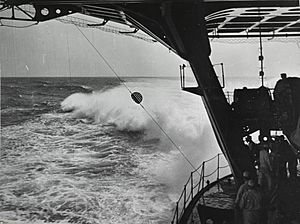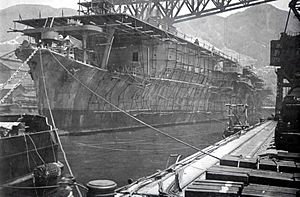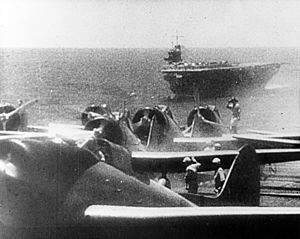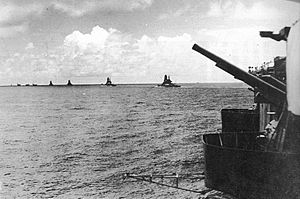Japanese aircraft carrier Sōryū facts for kids
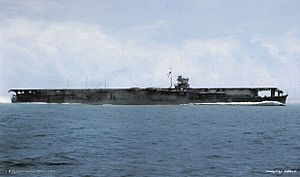
Sōryū on trials, January 1938
|
|
Quick facts for kids Class overview |
|
|---|---|
| Operators: | |
| Preceded by: | Ryūjō |
| Succeeded by: | Hiryū |
| Built: | 1934–1937 |
| In commission: | 1937–1942 |
| Completed: | 1 |
| Lost: | 1 |
| History | |
| Name | Sōryū |
| Namesake | Japanese: 蒼龍, meaning "Blue (or Green) Dragon" |
| Builder | Kure Naval Arsenal |
| Laid down | 20 November 1934 |
| Launched | 23 December 1935 |
| Commissioned | 29 December 1937 |
| Stricken | 10 August 1942 |
| Fate | Scuttled during the Battle of Midway, 4 June 1942 |
| General characteristics | |
| Type | Aircraft carrier |
| Displacement | |
| Length | 227.5 m (746 ft 5 in) (o/a) |
| Beam | 21.3 m (69 ft 11 in) |
| Draught | 7.6 m (24 ft 11 in) |
| Installed power |
|
| Propulsion |
|
| Speed | 34 knots (63 km/h; 39 mph) |
| Range | 7,750 nmi (14,350 km; 8,920 mi) at 18 knots (33 km/h; 21 mph) |
| Complement | 1,100 |
| Armament |
|
| Aircraft carried |
|
The Sōryū (meaning "Blue Dragon") was a special type of warship called an aircraft carrier. It was built for the Imperial Japanese Navy in the mid-1930s. Unlike some older carriers that were changed from battleships, Sōryū was designed as an aircraft carrier from the very beginning.
Sōryū's planes were used in battles during the Second Sino-Japanese War in the late 1930s. They also helped with the Japanese invasion of French Indochina in 1940. When the Pacific War started, Sōryū was a key ship. Its planes took part in the attack on Pearl Harbor, the Battle of Wake Island, and helped Japan take over the Dutch East Indies.
In February 1942, Sōryū's planes bombed Darwin, Australia. In April, they helped sink two British ships during the Indian Ocean raid.
After a quick repair, Sōryū joined three other carriers in the Battle of Midway in June 1942. After attacking American forces on Midway Atoll, the Japanese carriers were attacked by planes from the island and from American carriers. Dive bombers from the USS Yorktown badly damaged Sōryū and set it on fire. Japanese destroyers saved the crew, but the ship couldn't be saved. It was later sunk on purpose (scuttled) so the destroyers could be used for other missions.
Sōryū sank with 711 crew members lost out of 1,103. Losing Sōryū and three other Japanese carriers at Midway was a huge defeat for Japan. It played a big part in the Allies winning the war in the Pacific.
Contents
Design and Features
Sōryū was one of two large aircraft carriers that the Imperial Japanese Navy planned to build in the early 1930s. It was designed from scratch as a carrier, learning from earlier ships.
The ship was about 227.5 meters (746 ft 5 in) long, 21.3 meters (69 ft 11 in) wide, and had a draught of 7.6 meters (24 ft 11 in). It weighed about 16,200 tonnes (15,900 long tons) when empty and 19,100 tonnes (18,800 long tons) when fully loaded. The crew had 1,100 officers and sailors.
Engines and Speed
Sōryū had four powerful steam turbine engines. These engines, powered by eight large boilers, gave the ship a total of 152,000 shaft horsepower (113,000 kW). This power, combined with its sleek design, allowed Sōryū to reach a speed of 34.5 knots (63.9 km/h; 39.7 mph). This made it the fastest aircraft carrier in the world when it was first built!
The ship could travel about 7,750 nautical miles (14,350 km; 8,920 mi) (about 14,350 kilometers) at a speed of 18 knots (33 km/h; 21 mph) before needing to refuel. The smoke from the boilers went out through two funnels on the ship's right side, just below the flight deck.
Flight Deck and Hangar Decks
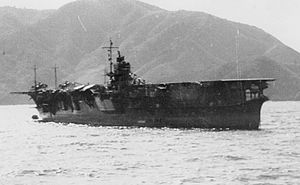
Sōryū's flight deck was 216.9-meter (711 ft 7 in) long and 26 meters (85 ft 4 in) wide. The "island" (the control tower) was built on the right side, sticking out from the hull. This way, it didn't take up space on the main flight deck.
The flight deck had nine wires that could stop planes quickly when they landed. The deck was only about 12.8 meters (42 ft) above the water. To keep it low, the ship's designers made the hangar decks (where planes were stored) shorter.
- The upper hangar was 171.3 by 18.3 metres (562 by 60 ft) and about 4.6 meters (15 ft 1 in) high.
- The lower hangar was 142.3 by 18.3 metres (467 by 60 ft) and about 4.3 meters (14 ft 1 in) high.
These lower heights sometimes made it hard to move planes around, especially larger ones like the "Kate" torpedo bomber, whose wings couldn't be folded or spread in the upper hangar.
Planes were moved between the hangars and the flight deck using three elevators. Sōryū could carry about 63 planes, plus 9 spare ones. It had a large amount of aviation fuel, about 570,000 liters (130,000 imp gal; 150,000 U.S. gal).
Weapons
Sōryū's main anti-aircraft (AA) weapons were six twin-gun mounts. Each mount had two 12.7 centimetres (5 in) guns. These guns could fire up to 14 rounds per minute and had a range of 14,700 meters (16,100 yd). They were controlled by special aiming systems.
For closer defense, the ship had fourteen twin-gun mounts with 25 millimetres (1 in) AA guns. These guns were the standard Japanese light AA weapon during World War II. However, they had problems, like not being able to aim fast enough at quick targets and having too much vibration. Their effective range was 1,500–3,000 meters (1,600–3,300 yd).
Armor Protection
To keep the ship light, Sōryū had minimal armor. Its main armor belt, made of special steel, was only 41 millimeters (1.6 in) thick. This protected the engine rooms and ammunition storage areas. The ship's deck was also lightly armored, only 25 millimeters (1.0 in) thick over the engine rooms and 55 millimeters (2.2 in) over the ammunition and fuel tanks.
Service History
Sōryū was named "Blue Dragon" following Japanese traditions for aircraft carriers. It was built at the Kure Naval Arsenal. The ship was started on November 20, 1934, launched on December 23, 1935, and officially joined the navy on December 29, 1937. It was then part of the Second Carrier Division.
In 1938, Sōryū's air group helped Japanese forces fighting in China, especially along the Yangtze River. They provided air support and defense. After these operations, the ship returned to Japan and spent much of the next year and a half training.
In 1940, Sōryū supported the Japanese invasion of French Indochina. In 1941, it helped blockade southern China. Later that year, it became the flagship of the 2nd Carrier Division.
Attack on Pearl Harbor and Other Operations
In November 1941, Sōryū joined the main Japanese fleet, called the Kido Butai, to attack the US Navy base at Pearl Harbor, Hawaii. On December 7, 1941 (Hawaii time), Sōryū and five other carriers launched two waves of planes.
- First Wave: Eight of Sōryūs torpedo bombers attacked ships in Pearl Harbor. They hit the target ship USS Utah and the light cruiser USS Raleigh. Other planes dropped bombs on battleships, possibly hitting one or two. Eight of Sōryūs Zero fighters attacked planes on the ground at Marine Corps Air Station Ewa, destroying many.
- Second Wave: Nine Zero fighters and seventeen dive bombers from Sōryū attacked other targets in Pearl Harbor, including Naval Air Station Kaneohe Bay.
After Pearl Harbor, Sōryū and another carrier, Hiryū, were sent to attack Wake Island. Their planes attacked ground targets and fought against American fighters, helping the Japanese take the island.
In early 1942, Sōryū supported Japanese invasions in the Dutch East Indies. On February 19, its planes took part in the air strikes against Darwin, Australia, sinking or damaging many ships. Later, Sōryū's dive bombers damaged the destroyer USS Edsall and sank the oil tanker USS Pecos. They also attacked Tjilatjep and Christmas Island before returning to base to prepare for the next big mission.
Indian Ocean Raid
On March 26, 1942, Sōryū and four other carriers left for the Indian Ocean raid. This mission aimed to protect newly conquered areas by destroying Allied bases and forces.
On April 5, Sōryūs planes attacked Colombo in Sri Lanka. They damaged port facilities. Later that day, Sōryūs dive bombers helped sink two British heavy cruisers, HMS Cornwall and HMS Dorsetshire.
On April 9, Sōryū's planes attacked Trincomalee. They were the first to bomb the port. Later, Sōryū also sent dive bombers to attack the small aircraft carrier HMS Hermes and other ships, sinking an oil tanker and a cargo ship. After these attacks, the Japanese fleet returned to Japan.
On April 19, while heading back to Japan, Sōryū and other carriers were sent to chase American carriers that had launched the Doolittle Raid on Tokyo. However, they found nothing and soon returned to Japan. Sōryū then underwent quick repairs and training for its next big operation.
Battle of Midway
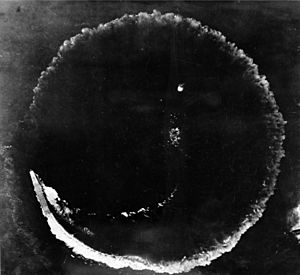
Japan's Admiral Isoroku Yamamoto wanted to force a big battle with the US Navy to destroy their aircraft carriers. He decided to invade Midway Atoll, believing this would draw out the American carriers.
On May 25, 1942, Sōryū sailed with the main Japanese carrier force for the attack on Midway Island. Its planes included Zero fighters, dive bombers, and torpedo bombers.
On June 4, 1942, Sōryū's planes were part of the first attack on the airfield on Eastern Island at Midway. They faced heavy fire, and some planes were lost or damaged. What the Japanese didn't know was that the US Navy had figured out their plans and set up an ambush with three of their own carriers.
Throughout the morning, Sōryū's fighters helped defend the Japanese fleet from American attacks from Midway Island. They shot down many American planes, including torpedo bombers and B-26 bombers. American B-17 bombers also attacked, but Sōryū and the other ships managed to avoid their bombs.
Around 10:20 AM, American dive bombers from the USS Yorktown arrived almost unnoticed. At 10:25 AM, Sōryū was hit by three 1,000-pound bombs. One bomb went through to the lower hangar deck, and the other two exploded in the upper hangar deck. The hangars were full of armed and fueled planes, which caused huge explosions and fires.
The fires quickly got out of control. By 10:40 AM, Sōryū stopped moving, and five minutes later, the crew was ordered to abandon ship. Destroyers rescued the survivors. Sōryū was still floating by early evening, so it was ordered to be sunk by torpedoes to free up the destroyers.
Sōryū sank at 7:15 PM on June 4, 1942. Out of its 1,103 crew members, 711 were lost, including Captain Yanagimoto, who chose to go down with his ship. This was the highest percentage of losses among the Japanese carriers sunk at Midway, mainly because of the terrible fires in the hangar decks.
The loss of Sōryū and the three other Japanese carriers at Midway was a huge defeat for Japan. It meant they lost two-thirds of their main aircraft carriers and many experienced aircrews. This defeat was a major turning point that helped the Allies win World War II. To hide the defeat, Sōryū was not immediately removed from the Navy's list of ships. It was finally removed on August 10, 1942.
See also
 In Spanish: Sōryū (1937) para niños
In Spanish: Sōryū (1937) para niños


